A path to gigantism: Three-dimensional study of the sauropodomorph limb long bone shape variation in the context of the emergence of the sauropod bauplan
- PMID: 35249216
- PMCID: PMC9296025
- DOI: 10.1111/joa.13646
A path to gigantism: Three-dimensional study of the sauropodomorph limb long bone shape variation in the context of the emergence of the sauropod bauplan
Abstract
Sauropodomorph dinosaurs include the largest terrestrial animals that ever lived on Earth. The early representatives of this clade were, however, relatively small and partially to totally bipedal, conversely to the gigantic and quadrupedal sauropods. Although the sauropod bauplan is well defined, notably by the acquisition of columnar limbs, the evolutionary sequence leading to its emergence remains debated. Here, we aim to tackle this evolutionary episode by investigating shape variation in the six limb long bones for the first time using three-dimensional geometric morphometrics. The morphological features of the forelimb zeugopod bones related to the sauropod bauplan tend to appear abruptly, whereas the pattern is more gradual for the hindlimb zeugopod bones. The stylopod bones tend to show the same pattern as their respective zeugopods. The abrupt emergence of the sauropod forelimb questions the locomotor abilities of non-sauropodan sauropodomorphs inferred as quadrupeds. Features characterizing sauropods tend to corroborate a view of their locomotion mainly based on stylopod retraction. An allometric investigation of the shape variation in accordance with size highlight differences in hindlimb bone allometries between the sauropods and the non-sauropodan sauropodomorphs. These differences notably correspond to an unexpected robustness decrease trend in the sauropod hindlimb zeugopod. In addition to forelimb bones that appear to be proportionally more gracile than in non-sauropodan sauropodomorphs, sauropods may have relied on limb architecture and features related to the size increase, rather than general robustness, to deal with the role of weight-bearing.
Keywords: Dinosauria; functional morphology; gigantism; graviportality; phylomorphospace.
© 2022 The Authors. Journal of Anatomy published by John Wiley & Sons Ltd on behalf of Anatomical Society.
Figures

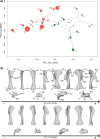
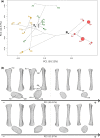
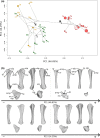

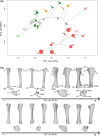
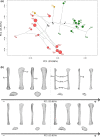


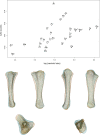

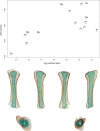
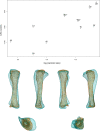
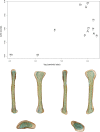
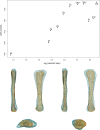
References
-
- 3D Systems . (2017) Geomagic wrap. Rock Hill, SC: 3D Systems.
-
- Adams D.C., Collyer M., Kaliontzopoulou A. (2020) Geomorph: software for geometric morphometric analyses. R Package Version 3.3.1.
-
- Adams, D.C. , Rohlf, F.J. & Slice, D.E. (2013) A field comes of age: geometric morphometrics in the 21st century. Hystrix, 24, 7.
-
- Agisoft LLC . (2018) Photoscan professional edition. St. Petersburg: Agisoft.
-
- Alexander, R. (1998) All‐time giants: the largest animals and their problems. Palaeontology, 41, 1231–1246.
Publication types
MeSH terms
Grants and funding
LinkOut - more resources
Full Text Sources

